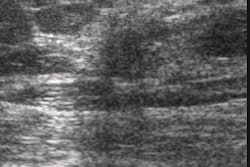(Ultrasound Review) According to researchers from the University of California, San Francisco, the growth between two ultrasound examinations can be used to predict neonatal outcome, even when gestational age is unknown. Because of normal variation in fetal size and the possibility of incorrect menstrual age, an alternative method to a single biometrical assessment was investigated. The authors hypothesized this should more accurately determine whether a fetus was pathologically small.
Published in Radiology, the study included 321 women with a singleton pregnancy that had two or more ultrasound examinations during the second and third trimesters. Measurements of the femur length, bipareital diameter and abdominal circumference were used to estimate fetal weight. In order to determine a normal distribution of fetal growth, they analyzed the estimated fetal weight data from 1,687 fetuses with known gestational age. Ideally the initial ultrasound examination should be performed after 20 weeks’ gestational age, as the authors believed this represented the first clinically relevant period. All ultrasound examinations were performed 2-17 weeks apart.
Results of the study determined that "inadequate fetal growth was associated with 3.9 times the risk of a birth weight less than 2500g, 17.7 times the risk of a birth weight less than the 3rd percentile for gestational age.’ Also, there was "2.3 the risk of preterm birth, 2.6 times the risk of a long newborn hospital stay, and 3.6 times the risk of neonatal intensive care unit admission."
It was revealed that inadequate fetal growth was better at identifying more fetuses with poor birth outcomes than a single estimated fetal weight that was lower than normal.
"Even the fetuses with an average weight were at an increased risk for poor outcomes if they demonstrated inadequate growth, they reported. Fetuses that were large for dates showed periods of slowed growth, but this had no deleterious effect on outcome, probably because they had already reached an adequate size. The authors concluded that "morbidity is significantly increased among fetuses who demonstrate less than expected growth."
"US evaluation of fetal growth: prediction of neonatal outcomes"R Smith-Bindman et al
Dept of radiology, University of California, San Francisco UCSF/Mt Zion Medical Center, San Francisco, CA
Radiology 2002 April; 223:153-161
By Ultrasound Review
May 29, 2002
Copyright © 2002 AuntMinnie.com



















